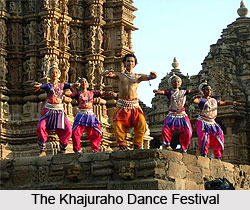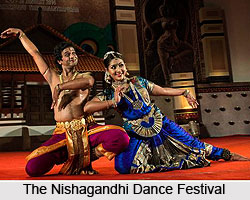India is a culturally rich country with varied dance forms. Since ancient days dance had been a well accepted performing art and had been reflecting diverse cultural traditions. India presents an amazing variety of dances; certain dances are religious in nature, while others are performed primarily for the purpose of entertainment or marking a festive occasion. The recognition of this performing art has initiated the exponents and admirers to organise a wide range of dance festivals across the length and breadth of the country.
India Dance Festivals are organised with an intention to promote the classical and regional dances of the state. These dance festivals can be regarded as a cultural fest and a platform to encourage the upcoming performers to keep the cultural legacy of the land intact.
History of Dance Festivals in India
History unveils that the Indian dance festivals were even organised in the long gone days of the `Rajas` and `Maharajas.` The beginning of these dance festivals was from the temples of India and gradually they were nurtured in the princely courts.
In the ancient days Indian Dance festivals were organised in few temples by the nobles or royals ministers who were in charge of the departments of arts and culture. Accordingly, dance festivals became a part of temple ceremony. The dance festivals were organised in the temple with a view that dance and temple would come close to each other. The saga of Indian dance festivals continued although the forms changed and even the style altered.
 Dance Festivals in Modern India
Dance Festivals in Modern India
In modern times dance has moved into the auditorium and has been reaching the mass through various ways. The dance festivals all over the country are organised with an aim to provide a platform to both dancers and art connoisseurs. In addition to that dance can be dealt as a mode of conveying information. Indian dance festivals became essential as a non verbal communication. Dance has been sending and receiving information and contributes to the social communication. The famous dance festivals of modern India include the Chennai dance and music festival, Pragjyoti International Dance festival, Pattadakal Dance Festival, Khajuraho Dance Festival, Mamallapuram Dance Festival, Chidambaram Dance Festival, Konark Dance Festival and many more.
Khajuraho Dance Festival
One of the renowned dance festivals held in the temples is the Khajuraho Dance Festival. Started in 197 by the government of Madhya Pradesh, it is one of the exclusive dance festivals which are still regarded as an outstanding one in modern times. Consequently, Khajuraho dance festival led the way for further preparation of dance festivals in all over the country.
Nishagandhi dance festival
Nishagandhi dance festival is another Indian Dance Festival which is conducted in the Nishagandhi Theatre. The dance festival held here highlights the brilliant performances by renowned Classical dancers and presents the rich cultural heritage of country. Musical concerts are also organised.
 Rajgir dance festival
Rajgir dance festival
This dance festival has attracted the attention of the tourists as well as the locals of Rajgir. Rajgir dance festival comprises performance of various singers and dancers from all over the country.
Chennai dance and music festival
Chennai dance and music festival is organized every year from the middle of December to mid January. Throughout the festival renowned artists perform and exhibit their talents.
Konark Dance Festival
Two dance festivals are held in Konark, Odisha. The first festival is organised in February by the Konark Natya Mandap. The second festival, organised by the state tourism department, is held in December. Both classical and folk dancers from all over India participate in these festivals.
Mamallapuram Dance Festival
Mamallapuram, a beach town near Chennai, is known for its 8th century shore temples. During December and January, a dance festival is organized here that brings notable exponents of the various Indian dance forms such as Bharatanatyam, Kathak, Kuchipudi, etc together.
Mukteshwar Dance Festival
Mukteshwar the 10th century temple in Bhubaneswar is the venue of the annual Odissi dance festival organised by the state tourism and cultural departments. Usually, the Mukteshwar Dance Festival is held in January.
Natyanjali Festival
Organised in honour of the presiding deity, Lord Nataraja that is Lord Shiva in his dancing avatar, Natyanjali Festival begins on the Maha Shivaratri day. More than a thousand year old temple forms the background of the five-day dance festival held in Chidambaram. The 108 poses of the Bharatanatyam are carved on the temple"s eastern gateway.
Hampi Dance Festival
Hampi dance festival is a major tourist attraction in Karnataka. This is an Indian classical dance festivals organized in October and November. This festival celebrates the culture and traditions of the Hampi through art and the ruins form the background of the festival.
Bamnia Chhau Dance Festival
Bamnia Chhau Dance Festival celebrates the folk dance Chhau with great enthusiasm. Held in the Purulia district of West Bengal, this is a folk style dance-drama that includes martial arts like movements and energetic dance movements. Dancers use colorful handcrafted masks for this particular dance festival.
Soorya Dance Festival
Soorya Dance Festival Kerala is a prominent cultural event organized by the Soorya Stage and Film Society. This festival is held in Thiruvananthapuram and continues for more than hundred days. The motto of this dance festival is to achieve “Integration through Culture†to propagate the rich Indian culture around the world.
Elephanta Dance Festival
Elephanta Dance Festival is organized by the Maharashtra Tourism Development Corporation (MTDC). This festival is celebrated on Elephanta island in Mumbai next to Elephanta Caves a UNESCO World Heritage Site, to promote culture and tourism.
Ellora Ajanta Dance Festival
Ellora festival, also known as the Ellora Ajanta Dance Festival in Maharashtra is organized by the Aurangabad Dance Committee. This three-day festival is an old-age tradition that focuses on appreciating the culture as well as the monuments and architecture of the city.
Modhera Dance Festival
Modhera Dance Festival is held at the Sun temple in Mehsana district. Tourism Corporation of Gujarat organizes this festival every year in January after the Kite festival gets over.



















